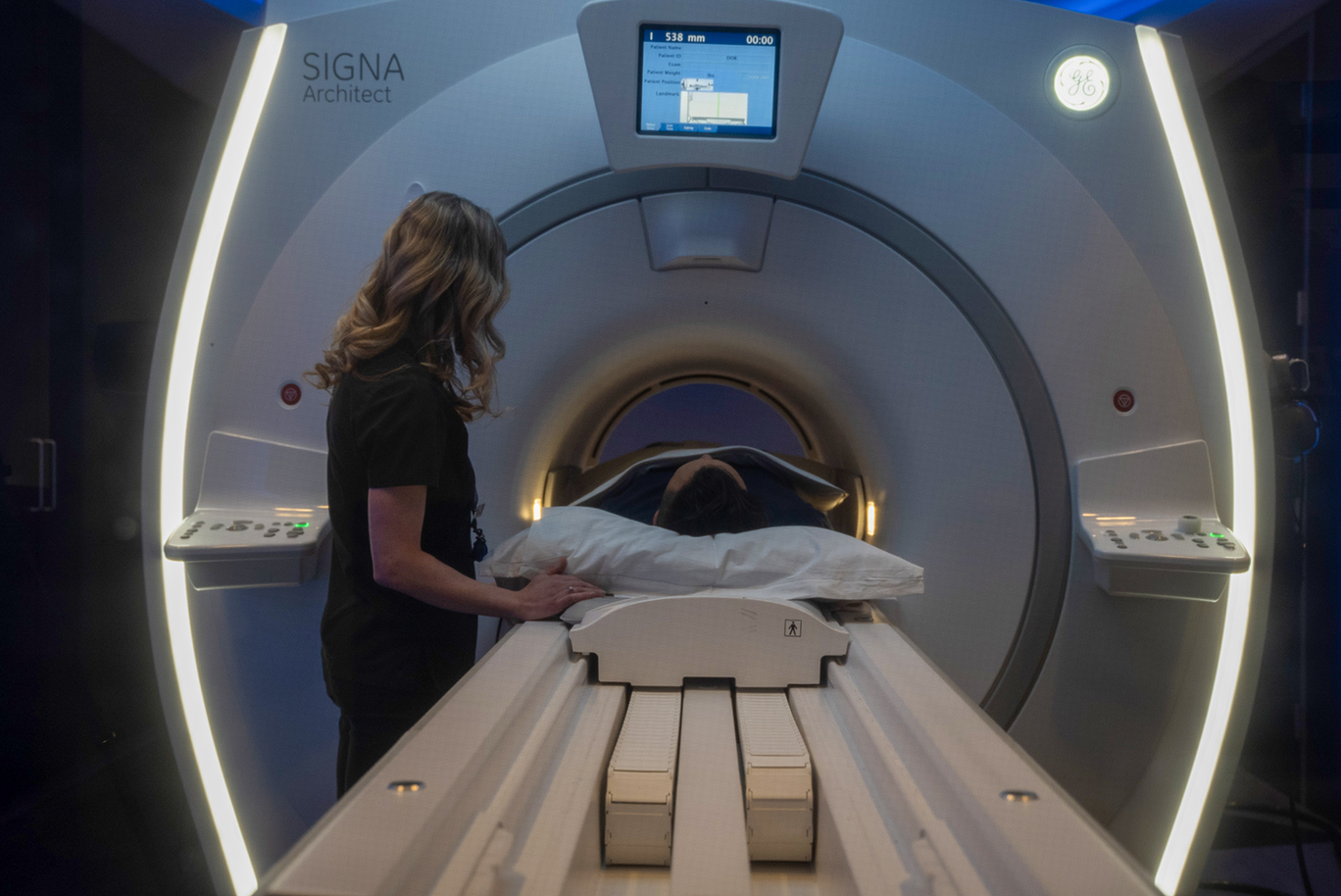TOLL FREE:
1-866-611-2665

Home HOW MRI AND CT WORK TOGETHER
Computed tomography (CT) and magnetic resonance imaging (MRI) are two types of medical imaging that have a reputation for providing a thorough look inside the body. They are often ordered when more detail is needed, or the cause of symptoms is unclear during a physical exam or on other types of imaging.
But sometimes it can be confusing to understand why one exam is requested and not the other, or why a patient might be sent for both types of scans. A patient’s medical and family history, risk factors, and type and duration of symptoms, all affect the physician’s decision on which type of imaging is appropriate.
“Although both CT and MRI are excellent tools for diagnostic imaging, each has its own strengths. This may influence which modality is best for a specific diagnosis,” says Rick Myszkowski, lead MRI technologist and Mayfair Place clinic manager.
An MRI scan creates images by exposing hydrogen atoms within our body to a magnetic field which controls the direction and frequency at which these hydrogen protons spin. A radio frequency pulse is then directed at a specific area of the body, while smaller magnets are used to alter the magnetic field on a small, but localized level.
As tissues responds differently to these magnetic field alterations, a computer can convert the data into a picture. MRI images can be taken of most body parts.
A CT scan is made from X-rays. While a standard X-ray machine sends only one radiation beam, a CT scanner emits a series of beams as it moves in an arc around the body. CT can demonstrate different levels of tissue density. This data is transmitted to a computer, which builds a 3D cross-sectional picture of area the body being scanned.
Whether a doctor requests a CT or an MRI scan often depends on the presumed diagnosis. For example, MRI is very good at examining soft tissues such as tendons and ligaments, evaluating the spinal cord, and identifying strokes in the brain. CT scans, in comparison, are best for imaging bone, soft tissues in the chest or abdomen, and blood vessels. A CT may be preferred to evaluate fractures or look for cancers or blood clots.
Whether it’s identifying a targeted area for treatment with surgery or an injection, finding an illness early, or excluding serious pathology, a clear diagnosis can provide peace of mind for patients.
An important difference between CT and MRI is that a CT scan involves radiation. This exposure to radiation in a CT scan is higher than that of standard X-rays, although the associated risk is still small. For example, the radiation exposure from one low-dose CT scan of the chest is the same amount of radiation as every person receives from the earth’s natural background radiation over six months.
MRI images, on the other hand, use a strong magnetic field, which can attract metal objects or may cause metal in your body to move. This means that before an MRI can be performed all patients will need to be screened to exclude internal metal objects that are not safe in the MRI. Compared to CT, the inside of the MRI scanner is slightly smaller and there are noises caused by changes in the magnetic field, which require ear protection.
To determine which imaging type is appropriate for a patient’s circumstances, a health care practitioner will review the risks and benefits associated with each type of imaging and determine whether CT or MRI will provide the most valuable information. Often, the benefit of detecting serious illness early will outweigh any discomfort or the small increased risk from radiation exposure.
CT and MRI exams are both available in hospitals and covered under the Alberta Health Care Insurance Plan, but they can also be performed as private pay exams which complement the public health care system.
Whether public or private, medical imaging must be requested by a health care practitioner who will provide a requisition. Mayfair Diagnostics will schedule your exam and provide you with detailed information to prepare for it. Once your exam is completed, your images will be reviewed by a specialized radiologist who will compile a report that is sent to your doctor. Mayfair Diagnostics is owned and operated by over 50 radiologists who are sub-specialty trained, which guarantees an expert opinion of your imaging.
Mayfair Diagnostics offers CT and MRI as private pay services at our Mayfair Place location.
National Institute of Biomedical Imaging and Bioengineering (2022) “Computed Tomography (CT).” National Institutes of Health, www.nibib.nih.gov. Accessed January 9, 2025.
Sawyers, T. (2023) “CT Scans vs. MRIs.” www.healthline.com. Accessed January 9, 2025.
Our Refresh newsletter delivers the latest medical news, expert insights, and practical tips straight to your inbox, empowering you with knowledge to enhance patient care and stay informed.
By subscribing to our newsletter you understand and accept that we may share your information with vendors or other third parties who perform services on our behalf. The personal information collected may be stored, processed, and transferred to a country or region outside of Quebec.
Please read our privacy policy for more details.